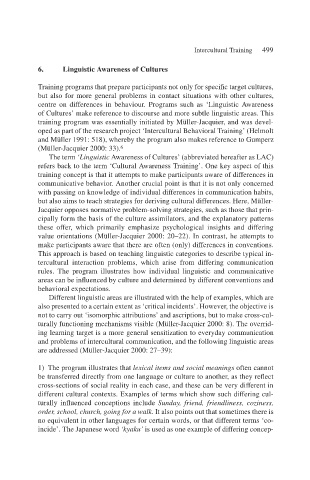Page 521 - Handbooks of Applied Linguistics Communication Competence Language and Communication Problems Practical Solutions
P. 521
Intercultural Training 499
6. Linguistic Awareness of Cultures
Training programs that prepare participants not only for specific target cultures,
but also for more general problems in contact situations with other cultures,
centre on differences in behaviour. Programs such as ‘Linguistic Awareness
of Cultures’ make reference to discourse and more subtle linguistic areas. This
training program was essentially initiated by Müller-Jacquier, and was devel-
oped as part of the research project ‘Intercultural Behavioral Training’ (Helmolt
and Müller 1991: 518), whereby the program also makes reference to Gumperz
(Müller-Jacquier 2000: 33). 6
The term ‘Linguistic Awareness of Cultures’ (abbreviated hereafter as LAC)
refers back to the term ‘Cultural Awareness Training’. One key aspect of this
training concept is that it attempts to make participants aware of differences in
communicative behavior. Another crucial point is that it is not only concerned
with passing on knowledge of individual differences in communication habits,
but also aims to teach strategies for deriving cultural differences. Here, Müller-
Jacquier opposes normative problem-solving strategies, such as those that prin-
cipally form the basis of the culture assimilators, and the explanatory patterns
these offer, which primarily emphasize psychological insights and differing
value orientations (Müller-Jacquier 2000: 20–22). In contrast, he attempts to
make participants aware that there are often (only) differences in conventions.
This approach is based on teaching linguistic categories to describe typical in-
tercultural interaction problems, which arise from differing communication
rules. The program illustrates how individual linguistic and communicative
areas can be influenced by culture and determined by different conventions and
behavioral expectations.
Different linguistic areas are illustrated with the help of examples, which are
also presented to a certain extent as ‘critical incidents’. However, the objective is
not to carry out ‘isomorphic attributions’ and ascriptions, but to make cross-cul-
turally functioning mechanisms visible (Müller-Jacquier 2000: 8). The overrid-
ing learning target is a more general sensitization to everyday communication
and problems of intercultural communication, and the following linguistic areas
are addressed (Müller-Jacquier 2000: 27–39):
1) The program illustrates that lexical items and social meanings often cannot
be transferred directly from one language or culture to another, as they reflect
cross-sections of social reality in each case, and these can be very different in
different cultural contexts. Examples of terms which show such differing cul-
turally influenced conceptions include Sunday, friend, friendliness, coziness,
order, school, church, going for a walk. It also points out that sometimes there is
no equivalent in other languages for certain words, or that different terms ‘co-
incide’. The Japanese word ‘kyaku’ is used as one example of differing concep-

